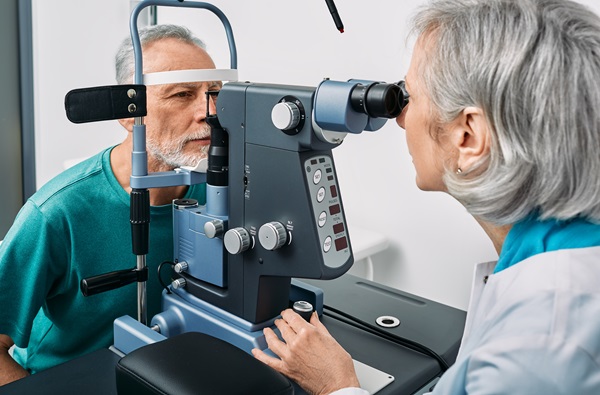Common Approaches to Glaucoma Treatment

Glaucoma is a group of eye conditions that damage the optic nerve and can lead to irreversible vision loss if left untreated. Fortunately, early detection and glaucoma treatment can help slow or prevent vision loss. These treatment methods, each tailored to a patient's specific needs and characteristics, focus on lowering intraocular pressure (IOP) and preventing the optic nerve from deteriorating.
Common Approaches to Glaucoma Treatment
While glaucoma treatment cannot reverse the damage of the disease, it can help slow or prevent further vision loss. This is especially true when an optometrist can catch the disease in its early stages. Here are some of the common approaches to glaucoma treatment.
Eye drops
Prescription eye drops are often the first line of glaucoma treatment. Some eye drops decrease the patient's eye pressure and improve how fluid drains from their eye. Other prescription eye drops decrease the amount of fluid that the patient's eye makes. Common prescription eye drop medications include:
- Alpha-adrenergic agonists. These types of eye drops reduce the production of the fluid that flows throughout the inside of the patient's eye while increasing the outflow of fluid from the eye
- Beta-blockers. These eye drops reduce the production of fluid in the patient's eye, helping to reduce eye pressure
- Carbonic anhydrase inhibitors. Optometrists prescribe patients to use this class of eye drops two to three times a day to reduce fluid production in the patient's eyes
- Prostaglandins. These eye drops increase the outflow of fluid in the patient's eye and reduce eye pressure
- Rho kinase inhibitor. This medicine lowers eye pressure by inhibiting the rho kinase enzyme, which increases fluid in the eye
Depending on the patient's needs and how low their eye pressure needs to be, they may need more than one type of eye drop.
Oral medication
Eye drops alone may not be sufficient to reduce the patient's eye pressure to the desired level. As a result, the optometrist may also prescribe oral medication for short-term use. This class of medication is a carbonic anhydrase inhibitor. The optometrist often uses it for adults with very high IOP who need to rapidly lower their eye pressure to protect their long-term vision health. Optometrists typically prescribe oral medication before more definitive treatment, such as laser eye treatment or surgery.
Laser therapy
Laser therapy, or laser trabeculoplasty, is an effective treatment option for patients who cannot tolerate eye drops. This treatment may also be necessary if medicine has not slowed the progression of the glaucoma. It targets different parts of the eye with minimal or no damage to surrounding eye structures. It typically targets the corner of which the iris and cornea meet, known as the trabecular meshwork, which is the main drainage system of the eye.
The optometrist can use different lasers to treat open-angle and closed-angle glaucoma. These include selective laser trabeculoplasty (SLT), argon laser trabeculoplasty (ALT), and laser peripheral iridotomy (LPI). SLT and ALT aim to improve fluid outflow in the trabecular meshwork. In contrast, LPI primarily treats acute or chronic angle-closure glaucoma by creating a hole in the iris to improve fluid drainage.
Laser therapy is minimally invasive and is an outpatient procedure, meaning the patient will leave on the same day. It may take a few weeks before the patient begins to experience the full results of the procedure. However, they are generally well-tolerated with limited recovery time and can be repeated if necessary.
Surgery
When medications and laser therapy fail to adequately control glaucoma or, in more advanced cases, surgical interventions may be necessary. Filtering surgery, or trabeculectomy, is a traditional surgical procedure where the doctor creates a new drainage channel in the white of the eye (sclera) to bypass the blocked trabecular meshwork. While effective, trabeculectomy carries risks such as infection, bleeding, and cataract formation.
Another common surgical glaucoma treatment is placing drainage tubes or glaucoma drainage devices (GDDs). During this procedure, the doctor inserts a small tube into the patient's eye. The tube drains excess fluid to lower eye pressure.
Additionally, minimally invasive glaucoma surgeries (MIGS) have emerged as a less invasive treatment for patients seeking a surgical procedure with fewer postoperative risks and complications. Often combined with cataract surgery, MIGS procedures aim to enhance eye fluid outflow while minimizing tissue trauma and postoperative complications. There are a number of MIGS techniques available, and the patient can work with their doctor to decide which option is right for them.
Regular monitoring and follow-up
Regardless of the chosen treatment option, the patient will need to continue undergoing regular monitoring and follow-up with their optometrist to effectively manage their glaucoma. During these appointments, the optometrist will assess the patient's visual function, measure IOP, evaluate the optic nerve, and perform visual field tests.
Based on these evaluations, the doctor may need to adjust the glaucoma treatment plan, particularly if the disease has progressed or is causing further complications. Open communication and regular attending these follow-up appointments are essential to long-term glaucoma care.
Get the glaucoma treatment you need today
If you or someone you know has been diagnosed with glaucoma recently, early detection and treatment can help prevent vision loss and maintain optimal eye health for years to come. While being diagnosed with this disease can be stressful, there are glaucoma treatment options out there. Call our office to learn more about our treatment services or schedule a consultation.
Request an appointment here: https://www.texasoptical.net or call Texas Optical at (214) 771-7333 for an appointment in our Dallas office.
Check out what others are saying about our services on Yelp: Read our Yelp reviews.
Recent Posts
For those living with diabetes, undergoing a diabetic eye exam is one of the most important steps in protecting their vision and overall eye health. High blood sugar levels can lead to a range of complications, including conditions that damage the eyes over time. These exams help detect these issues before they become serious, allowing…
Contact lenses provide clear vision and convenience for individuals who prefer an alternative to eyeglasses. However, proper care and maintenance are essential to prevent infections, irritation, and eye damage. Neglecting hygiene practices can lead to serious eye conditions, including corneal ulcers and keratitis. Understanding how to clean, store, and handle contact lenses ensures long-term eye…
Maintaining eye health and preventing long-term issues is the result of consistent and quality vision care. Many people focus on overall wellness but may overlook daily habits that support healthy eyesight. However, taking simple steps each day can protect vision, reduce eye strain, and prevent future complications. By making eye health a priority, it is…
Prescription contacts provide vision correction, comfort, and convenience for those who do not want to wear glasses. However, caring for and wearing contacts takes some getting used to. Learning to insert, remove, and maintain them will help ensure a comfortable and safe experience.Not all contact lenses are the same, and choosing the right pair is…


